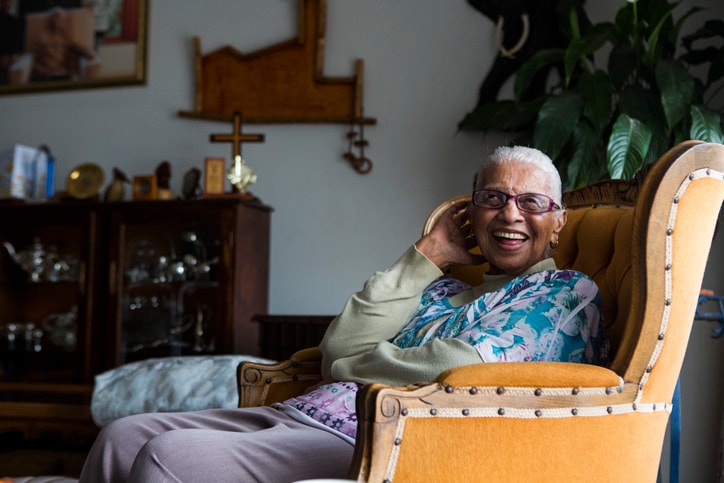In this article
As evening approaches, you might notice your loved one with dementia becoming increasingly agitated, confused or restless. This late-day shift in behavior is known as sundown syndrome, or sundowning, and while it’s common, it can be one of the more distressing aspects of caregiving.
“Sundown syndrome describes a collection or range of symptoms that a person may experience when they have cognitive difficulties,” explains Dr. Daniel Lesley, a board-certified neurologist at Remo Health. “These may include agitation, anxiety, irritability, worsening of thinking or behavior, pacing, confusion, and a variety of similar issues that can often get worse into the evening.”
Roughly 20% of people with Alzheimer’s disease experience sundowning, according to the Cleveland Clinic. It’s especially common in the middle to late stages of dementia, but can occur earlier, too. So, why does sundowning happen, and what can you do to help? Here’s what experts want you to know.
Key takeaways
- Sundown syndrome, or sundowning, is a common occurrence in middle to late stage dementia. It can be defined as increased confusion, agitation and behavioral changes that tend to worsen in the late afternoon or evening.
- Sundowning symptoms may be triggered by fatigue, changes in lighting, disruptions to someone’s normal routine and overstimulation. While sundowning is most common in later stages of illness, it can happen at any point.
- Dementia caregivers can ease symptoms of sundowning by establishing a calm, consistent evening routine. This should include managing noise and lighting. If symptoms persist, it’s vital to seek medical guidance for advice and treatment.
What are the symptoms of sundown syndrome?
The symptoms of sundowning can range from subtle changes in behavior to more severe disruptions. “Caregivers often begin noticing sundowning when a loved one starts showing extreme confusion, distressed behaviors, restlessness or agitation in the late afternoon or evening,” notes Dr. Macie Smith, a gerontologist with Synergy HomeCare.
Common first signs of sundowning may include:
- Increased confusion or disorientation.
- Mood changes or irritability.
- Restlessness or pacing.
- Mild anxiety or fear.
- Repetitive behaviors (like asking the same question).
- Following caregivers around (shadowing).
In more severe cases, your loved one might experience:
- Intense agitation and pacing.
- Paranoia or suspicion of family members.
- Hallucinations (seeing, hearing or even smelling things that aren’t there).
- Aggression or outbursts.
- Wandering or attempting to leave home.
“It’s important to keep in mind that every person with dementia is unique and experiences different symptoms,” emphasizes Lesley. The symptoms can also be inconsistent. Your loved one might seem slightly weepy one evening and irritable the next, making it difficult to recognize the pattern right away.
Frequency varies significantly between individuals. Erik Reynolds, owner of Visiting Angels in Littleton, Colorado, explains that “caregivers might first notice changes a few times per week, eventually becoming a near-daily occurrence” as dementia progresses.
“Sundowning can be incredibly stressful, but asking for help is a strength — not a failure.”
— Erik Reynolds, home care expert
What are the causes of sundowning?
Understanding the triggers of sundowning can help families better manage and even potentially prevent episodes. Lesley compares it to the brain losing its “paddle” in a river of overstimulation and fatigue: “Someone with dementia is already using that paddle to stroke furiously against the current just to stay in place. But if they get tired, distracted or drop the paddle, they’re no longer able to compensate and go over the falls with a crash.”
Here are some of the most common triggers:
Fatigue
As mental energy wears down, people with dementia often reach their limit by evening. “After a long day, someone with dementia may be too tired to process the world around them clearly,” Smith explains.
Low or changing light
As natural light fades, familiar surroundings can appear altered or threatening. “As the sun sets,” Smith says, “changes in lighting and shadows can make someone with dementia feel disoriented, confused or fearful.”
Disrupted circadian rhythms
“The exact reasons why sundowning happens aren’t fully understood, but it seems to be tied in part to our body’s ancient, built-in daily rhythms,” Lesley says. For people with dementia, normal afternoon energy dips can feel overwhelming when their cognitive resources are already tapped out.
Environmental overstimulation
A noisy household or too much activity at the end of the day can overwhelm someone whose brain is already working overtime to manage basic tasks. Smith notes that “loud noises, disruptions in routine, or unfamiliar people can make things unsettling.”
Changing or unfamiliar routines
Changes to a daily routine — even minor ones — can heighten anxiety. Long-term memories of past routines can also play a role. “Because long-term memory stays intact for so long, someone with dementia could begin to relate the sun going down with past experiences, such as driving home from work, picking kids up from school or preparing dinner,” explains Smith. “They set out in search of something familiar, causing extreme confusion and agitation when they can’t physically connect with their past lifestyle.”
Hunger or thirst
Basic needs like hunger or dehydration can contribute to agitation, especially if your loved one can’t easily express them.
Medication side effects
Some medications, particularly anticholinergics (like Benadryl or Tylenol PM), can interfere with sleep cycles and increase confusion.
Seasonal changes
Shorter winter days or early darkness may worsen sundowning symptoms.
Can sundowning occur without dementia?
Yes, sundowning can occur even if an aging adult doesn’t have dementia — though it’s less common. According to Lesley, sundowning-like behaviors may appear in people with bipolar disorder, certain neurological conditions or young children with brain issues. However, outside of dementia, the term “sundowning” is rarely used.
Seniors without a dementia diagnosis may experience similar symptoms due to sleep disturbances or conditions like Parkinson’s dementia. Certain medications or underlying sleep disorders can also trigger sundowning-like symptoms in vulnerable individuals.
In what stage of dementia is sundowning most common?
“Sundowning can sometimes happen in people in the earlier stages of dementia, but it’s most common in people who are in the middle or later stage of dementia,” explains Lesley. However, every individual’s experience varies, and the progression differs from person to person.
Episode duration and timing
The timing and frequency of sundowning can vary widely. Episodes might occur for a day or two, then disappear for weeks before returning. It’s the consistent pattern over time that indicates sundown syndrome rather than isolated incidents.
“Episodes usually begin in the late afternoon or early evening and can last several hours, though it depends on the individual and environment,” Reynolds says.
How to manage sundown syndrome symptoms
There’s no single cure for sundowning, but creating and maintaining a predictable, familiar routine is one of the most effective things a caregiver can do for their loved one. “For someone with dementia, knowing what to expect each day can bring a sense of security,” says Smith.
Here’s what experts recommend:
Establish a routine
Stick to a predictable schedule. Limit naps and avoid packing in too many activities. Familiarity helps reduce anxiety. Reynolds emphasizes that “sticking to a routine provides reassurance and stability, which can help prevent or lessen sundowning behaviors.”
Keep tabs on diet
Monitor your loved one’s diet for patterns that might trigger symptoms. “Avoid things like caffeine or naps late in the day, which can throw off sleep patterns,” Smith suggests. Steer clear of alcohol and sugary foods too, especially in the evening hours.
Control noise
Create a calm environment for your loved one by reducing background noise. “As the day winds down, create a peaceful space by turning off loud noises like the television or radio and speaking in a calm voice,” Smith recommends. Consider avoiding evening visitors who might create additional stimulation.
Let light in
Lighting management can help minimize sundowning symptoms. “Consider brightening the lights to reduce the impact of dusk on somebody who may already have difficulties with vision and who becomes more agitated when they can’t see,” Lesley says. Some families find success with light therapy boxes that provide full-spectrum lighting to help regulate circadian rhythms.
Smith adds another practical tip: “Close the curtains so they don’t see the sun going down” to prevent visual triggers associated with end-of-day anxiety.
Should you see a doctor about sundown syndrome?
When sundowning becomes overwhelming, it’s OK to ask for help.
“If the caregiver is concerned about their loved one’s health or safety or they are feeling overwhelmed and breathless, then it’s time to call in some reinforcements,” Smith says. Consider in-home support or consult with your loved one’s doctor about additional management strategies.
Most importantly, remember that you’re not alone in this journey. As Reynolds puts it: “Sundowning can be incredibly stressful, but asking for help is a strength — not a failure.” Taking care of yourself is essential for providing the best possible care for your loved one with dementia.





